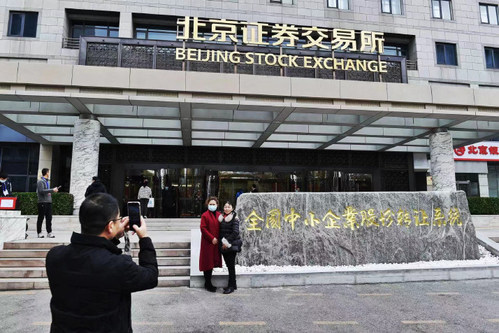Beijing, October 8 August 2022 /PR Newswire/ – Author Pastor of BeijingIE: United Nations January 2110 days before the Spring Festival holiday (from January 31st to February 6th this year), the workshop of Baoji Saiwei, a heavy machinery manufacturer in Baoji, Shaanxi Province in the northwest China, are in full swing to fulfill their orders. By the end of 2021, Saiwei has already received orders for the first half of 2022.Deputy General Manager Li Hui Tell Beijing Review, “We need to deliver products in a timely manner and reach new markets.”

Beijing Stock Exchange will open on November 15, 2021, focusing on providing financial support for innovative small and medium-sized enterprises (Weiyao)
On the same day, in the capital BeijingDu Peifan, founder of Zhiqing Finance, an artificial intelligence (AI) company focused on intelligent voice services, is doing his day job, getting his employees to serve their bank customers through checklists.
the next day, January 22in Yiwu, the eastern province known as the world’s largest consumer goods wholesale market Zhejiang, Wei Lingying, CEO of OMA Wine International, a company that imports Spanish wine and food, is busy taking orders and delivering.Wei even struggled to squeeze in beijing review interview.
Despite operating in different industries and playing their respective roles in the market, all three are the strongest components of China’s economy – the small and medium-sized enterprises (SMEs).
China’s Small and medium-sized enterprises account for about 99% of the total number of enterprises in the country, and they are the main force behind China’s Economic growth. According to the 2020 report of the Ministry of Industry and Information Technology, more than 50% of the country’s tax revenue and 60% of GDP come from small and medium-sized enterprises. They create 70% of technological innovation and 80% of urban jobs.
However, these companies do face many difficulties and concerns in further development.
lively
The COVID-19 outbreak, rising commodity prices, supply chain issues and financing difficulties all pose serious challenges.
Higher spending on imported wine and food, coupled with a drop in demand due to the pandemic, has kept OMAWine International on edge. Wei said orders for wine during the peak sales season before the Spring Festival this year have dropped by 20 percent compared with before the epidemic.
On the plus side, all three companies are still alive, inspiring those willing to try their hand at entrepreneurship.
Saiwei only briefly halted production at the start of the COVID-19 pandemic in early 2020 and resumed operations shortly thereafter. “Like gears, we are inseparable parts that guarantee fast operation China’s Industrial chain and supply chain,” Li said. “We, SMEs or private enterprises, cannot simply give up and shut down; we are not just businesses, but the economic backbone of our workers’ families. “
trials and tribulations
Zhang said SMEs are usually clustered in highly competitive industries, which makes it crucial to adjust their business models and actively look for new growth opportunities in the new market environment.
Compared with large smart voice companies that only offer one standard product, ZhiqingQin has better customized services, especially in the after-sales field, Du said. The pandemic has generally spurred technological expansion, and artificial intelligence is now widely used. However, financing remains an issue. Increasing the company’s capital to invest in technical capabilities and service research is a daunting task for Du.
Pan Gongsheng, Deputy Governor of the People’s Bank of China ChinaThe country’s central bank said at a press conference September 2021 Addressing the financing needs of SMEs is a high priority for regulators.Total Small and Micro Enterprise Loans 17.8 trillion yuan ($2.75 trillion) if or late July 2021according to Pan, a year-on-year increase of 29.3%.
High-tech SMEs like Saiwei have also received financial aid. Unlike conventional businesses that produce heavy machinery, Saiwei caters to specific customer needs.Last year, it invested about 30 million yuan ($4.7 million) in research and development.
The company has been selected into the “Little Giant Enterprise” program, covering small enterprises in the early stage of development, all of which are based on high-end technology. This could bring millions of RMB in research support for Saiwei in the coming year. Your company has also applied for the program.
So what’s the future China’s SMEs? There are two answers: According to the government’s guidelines, innovation leadership and green development will be the two key directions to drive its high-quality growth during the 14th Five-Year Plan (2021-25).
Source Beijing Review
